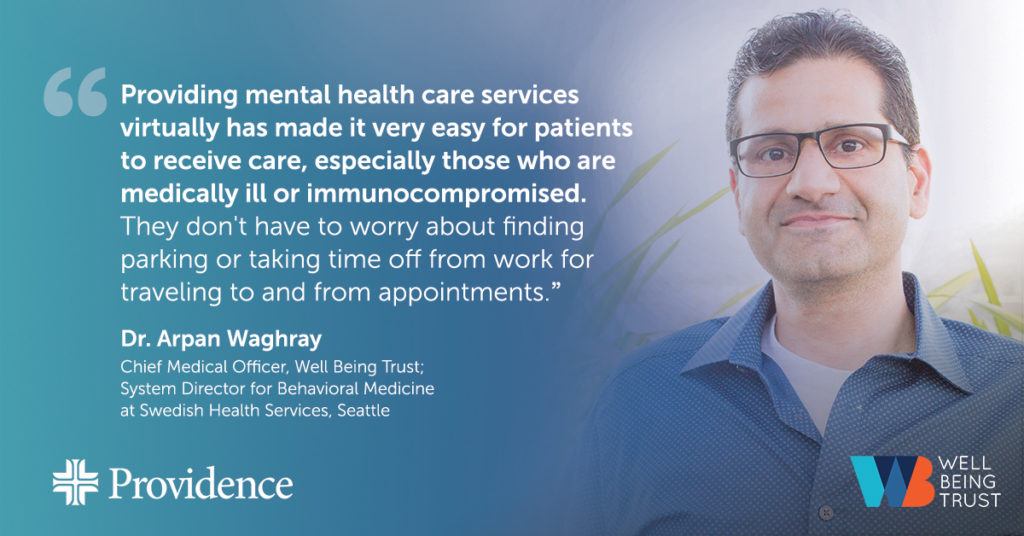How Providence St. Joseph Health Medical Group transitioned to telehealth during a pandemic
When the COVID-19 pandemic effectively shut down the nation in March, health care providers everywhere faced an enormous, time-sensitive challenge: they had to quickly shift services online in order to continue caring for patients while adhering to the emergency public health guidelines in place.
For behavioral health providers at Providence St. Joseph Health, this transition was supported by ongoing work — underway long before the virus’ spread — to adopt telehealth models of care across the system. By August 2020, Providence providers have completed more than 40,000 telehealth visits — five times as many than they had in all of 2019.
“Behavioral health lends itself quite naturally to telehealth, helping us lead a fairly seamless transition for patients and providers alike,” said Dr. Arpan Waghray, Chief Medical Officer at Well Being Trust and system director for behavioral medicine at Swedish Health Services within Providence.
As the nation continues to adapt to a new normal, Providence is also adjusting to new standards for hybrid and virtual models that will ensure sustainable, equitable and accessible care in the months and years ahead.
Improved access and quality of care
In response to stay-at-home orders at the start of the pandemic, Providence’s behavioral health services went completely virtual. After six weeks, they began shifting to the hybrid model that’s in place today, with some patients coming into the office and others continuing to receive care virtually. This flexibility has been especially valuable for patients who are at a higher risk of serious complications from COVID-19.
“Providing mental health care services virtually has made it very easy for patients to receive care, especially those who are medically ill or immunocompromised,” Waghray said. “They don’t have to worry about finding parking or taking time off from work for traveling to and from appointments — many patients are really enjoying the convenience factor of this care model.”
Lack of access to behavioral health care is an issue that predates the spread of COVID-19 in the U.S. Providence launched a telepsychiatry program in 2017, designed to meet the needs of behavioral health patients at rural hospitals where they don’t have access to psychiatric care. Since the program went live, providers have successfully navigated the initial challenges of telehealth, such as new technologies, adjusted workflows, and culture shifts.
But accessibility is just the beginning of the benefits that come with telehealth. Providers have also seen improved engagement from patients, and no-show rates have gone down significantly since moving online. For Henry Lauer, a social worker at a multi-disciplinary pain clinic within Providence, this has been particularly critical for his patients.
The no-show rate is typically very high because people who are in pain are more likely to miss their appointments due to flare-ups, Lauer said. But with telehealth, those patients can still make their appointments online.
Although not all services at the pain clinic translate perfectly to virtual care, it has still been helpful for patients in different ways. For example, a patient who lives more than 1.5 hours away and whose pain symptoms are exacerbated by car travel can really benefit from online sessions with Lauer, something that had not been an option prior to March.
As Providence continues to improve its virtual behavioral health care model, Waghray said they are also looking to understand what other digital solutions can be made available to patients, such as computerized cognitive behavioral therapy and other kinds of virtual modules that patients can use themselves. Accessing secure technology and ensuring proper protocols are in place are also important steps to ensure virtual care remains safe and sustainable.
Adjusting to a new model of care
With major changes like this, some initial challenges and adjustments are a natural part of the process. The quick adoption of new technology platforms, for example, presented a learning curve to patients and providers alike. Many patients are not familiar or comfortable navigating online behavioral health visits, which means providers take on the additional role of stepping in to provide support, walk patients through the process and help them feel comfortable accessing these visits.
Another challenge for providers has been learning how to pick up on non-verbal cues virtually, said Dr. Tyson Payne, a behavioral health provider at Southwest Pediatrics within Providence. Because micro-expressions and tones may not be conveyed accurately through video and you see less of how patients’ interact with their parents before they enter the room, there is more that could be missed through virtual care, he said.
Building rapport and finding ways to connect with pediatric and adolescent patients has also looked different with telehealth, Payne said. Before, he would play games and joke around with his patients to get them comfortable and engaged. Now, he says he has to challenge his usual style and find new ways to get kids’ attention from the get-go. Getting creative with online whiteboard features, for example, has helped in this area.
Despite these new challenges, providing behavioral health care online has proved beneficial to many patients, especially during the pandemic.
COVID-19 has increased a lot of patients’ anxiety, Payne said, and many of his patients would not be comfortable with an in-person visit during this time. It’s especially helpful for his patients whose parents can’t physically bring them into the clinic, so they can still have their visits online.
“If it were not for telehealth visits, many patients would not be accessing care right now,” Payne said. “Virtual care is helping meet patients exactly where they’re at, and it’s providing access to people who wouldn’t have had it otherwise.”






